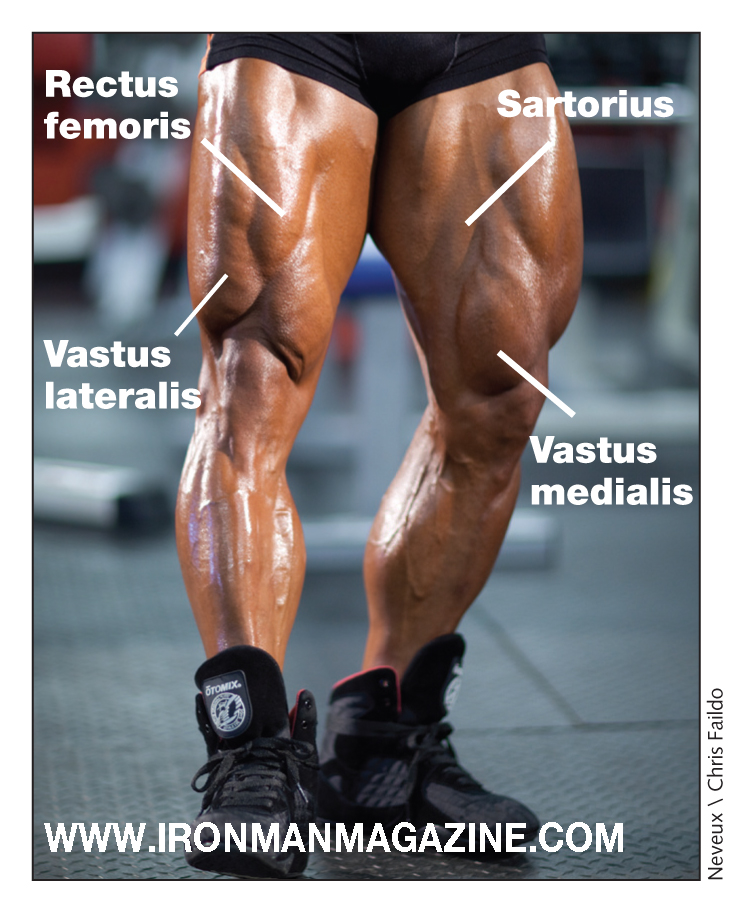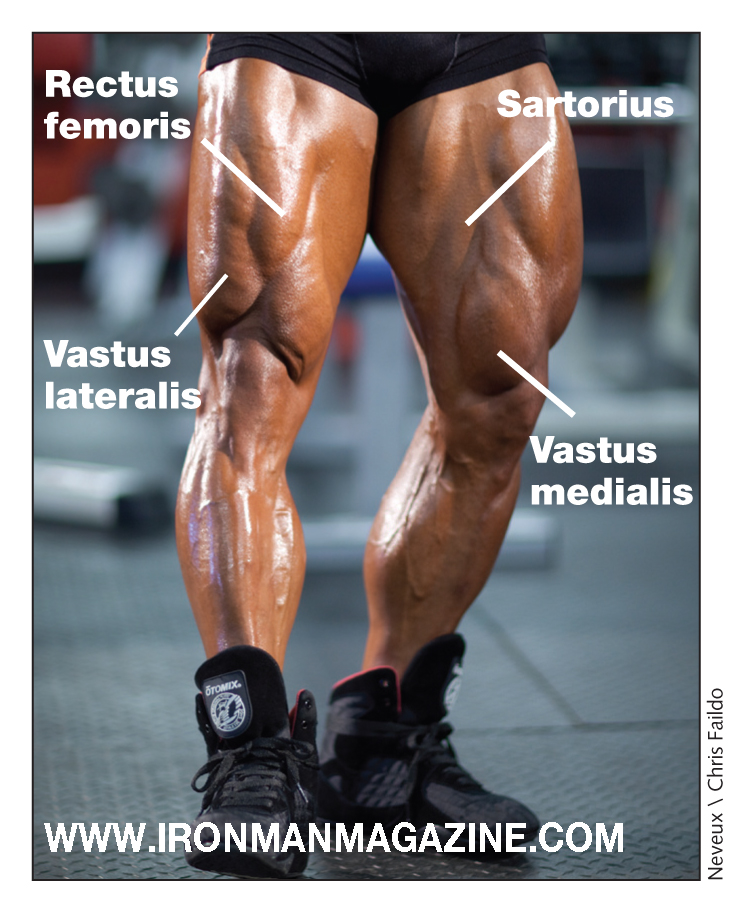

 Q: Is there a difference between the “thighs” and the “quads”?
Q: Is there a difference between the “thighs” and the “quads”?
A: Yes. The thigh includes the quadriceps femoris, or quads, but the quads alone are not the entire thigh. The thigh is composed of three large groups of muscles and a few much smaller muscles.
The quads are a group of four muscles of the front thigh—the rectus femoris, vastus lateralis, vastus medialis and vastus intermedius. The rectus femoris is the central quad muscle, the vastus lateralis is the outer quad muscle, the vastus medialis is the inner “tear-drop” quad, and the vastus intermedius is not visible because it’s beneath the rectus femoris. The tendons of insertion of the four quadriceps muscles form the patella—knee cap—tendon.
The rectus femoris connects the tibia, or shinbone, (through the patella) to the pelvis, whereas the other three quad muscles connect the shinbone (also through the patella) to the thighbone, or femur. The rectus femoris raises the femur, flexing it, at the hip joint and extends the leg at the knee joint; the other three quad muscles extend the leg only. Extending the leg at the knee joint means to straighten it.
Another big group of thigh muscles is the hamstrings—the three muscles of the rear thigh—the two-headed biceps femoris, semitendinosus and semimembranosus. They flex the knees and contribute to hip extension, moving the thighbone backward. To flex the knee means to bring the heel backward towards the hips.
The third big group of thigh muscles is the thigh adductors, or groin muscles. There are five major adductors of the thighbone in the inner thigh. They are responsible for adduction, flexion, and lateral rotation of the thighbone. Adduction means to bring the thighs together, and flexion to move the thigh toward the chest.
A small contribution to the mass of the thigh comes from the sartorius and the hip flexors. The sartorius is the longest muscle in the body and runs diagonally across the front thigh, from the upper end of the shinbone, to the outer edge of the pelvic girdle. The sartorius flexes the thighbone and rotates it laterally.
The iliopsoas is the single name for three hip flexors—the iliacus, psoas major and psoas minor—that fuse into a single tendon on the thighbone. They originate on the pelvis or on some of the lower vertebrae of the spine and are hidden from view. They raise the thighbone and rotate it laterally. (Another hip flexor is the visible rectus femoris, discussed above.)
Q: Should I deadlift in a power rack or from the floor?
A: It depends on your body structure. If you have, relatively speaking, a long torso and short legs, you’re likely to find the deadlift very challenging technically; however, if you have a shorter torso and long legs, you will probably find the deadlift much less challenging, technically. Even if you’re well put together for the deadlift, you can still commit technical outrages with it. And even if you find the deadlift very awkward, you may still be able to perform it effectively, albeit modified.
When lifting challenging weights—or when lifting any type of weight if you’re out of condition—always do it without rounding your back. Lifting with bent knees, a forward lean of the torso and a slightly hollow lower spine, is the safest way to handle any medium or heavier weight, even for a well-conditioned bodybuilder. If you can maintain such good deadlifting technique while taking the loaded barbell from the floor, do it. It will give you a greater range of motion and greater muscle involvement than a deadlift taken from an elevated position.
The benefit from deadlifting in a power rack, from off the rack’s pins, is that you take the barbell from a higher position than you would if you lifted from the floor, outside of the rack. Taking the bar from an elevated position reduces the range of motion and makes it easier to maintain the safe, slightly hollow lower spine. That’s an excellent strategy to adopt if you can’t maintain correct exercise technique on a full-range deadlift from the floor. In that a case a common strategy is to deadlift from two or three inches below knee height, which involves minimal flexion of the knees, and is really a partial stiff-legged deadlift.
—Stuart McRobert
www.Hardgainer.com
Editor’s note: Stuart McRobert’s first byline in IRON MAN appeared in 1981. He’s the author of the new BRAWN series, Book 1: How to Build Up to 50 Pounds of Muscle the Natural Way, available from Home Gym Warehouse (800) 447-0008 or www.Home-Gym.com.




















You must be logged in to post a comment Login